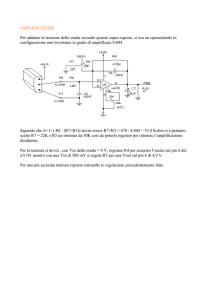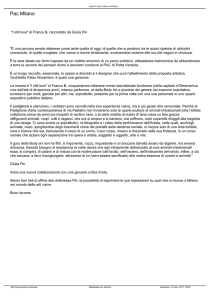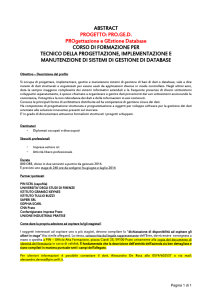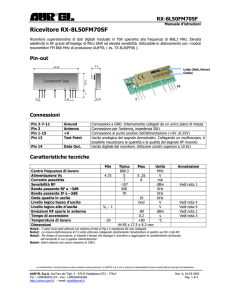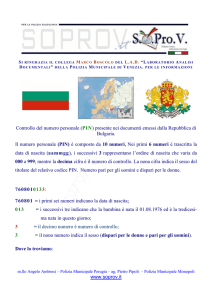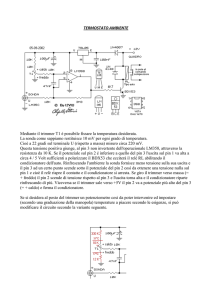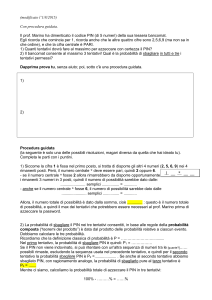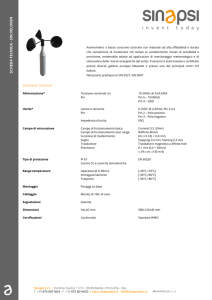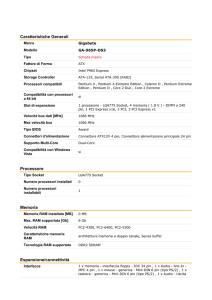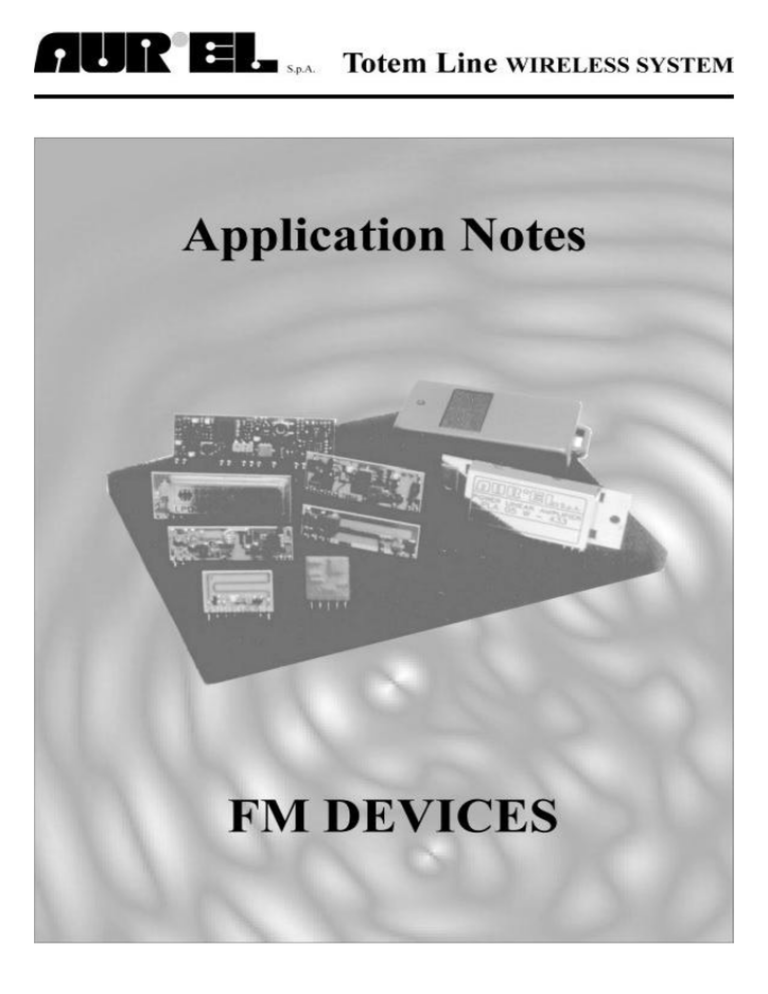
TOTEM LINE
Rev. 1098
Index
Page
Index • Indice
I
Section 1 : Audio RF System • Sistema RF Audio
FM transmitter • Trasmettitore FM
TX FM AUDIO
1-1
Super-het FM receiver • Ricevitore FM super-eterodina
1-3
RX FM AUDIO
Section 2 : Digital Data RF System • Sistema RF per Dati Digitali
FM transmitter • Trasmettitore FM
2-1
TX-DFM-12V
Super-het FM receiver • Ricevitore FM super-eterodina
2-5
RX-DFM-3V3
I
Totem Line
S.p.A.
Via Foro dei Tigli, 4 • Phone : +39-0546941124 • Fax : +39-0546941660 • I 47015 Modigliana (FO) Italy • http://www.aurel.it • E-mail: [email protected]
FM audio transmitter • Trasmettitore FM audio
mod. TX
FM AUDIO
FM audio transmitter usable in conjunction with
mod. RX FMAUDIO receivermodule.
Ideal for applications like audio HI-FI transmission, radio call alert
and remote control (DTMF) systems. ETS 300 220 homologable.
Modulo trasmettitore FM audio abbinabile al modulo ricevitore
mod. RX FM AUDIO. Ideale per applicazioni quali trasmissione
audio HI-FI, allarme via radio (telesoccorso) e controllo remoto
(DTMF).Omologabile ETS 300 220.
(Scale 1:1)
Block diagram
ENABLE SWITCH
Pin-out
x5
x 20
2
3
4
5
MATCHING
NETWORK
1) +12V
2) Tx-Enable (5÷12V)
3) Ground
4) Input 1 (LF)
5) Ground
6) Output 1 (LF)
AMP 2
AMP 1
1
FM
MODULATOR
6
7
9
22K
4K7
13
15 16
7) Input 2 (LF)
9) Ground
13) Ground
15) RF Output
16) Ground
PRE-EMPHASIS
NETWORK
5n6F
Technical Specification
Caratteristiche Tecniche
* High-reliability SIL thick-film hybrid circuit ;
* Carrier frequency : 433.8 MHz obtained by
SAW resonator ;
* FM modulation with ∆fMAX = ± 75 KHz ;
* Modulation sensitivity : 100 mVpp in order to reach
∆fMAX (see application note) ;
* Audio bandwidth : 20 Hz to 30 KHz ;
* Supply : +12V ± 10% ;
* 15 mA consumption with TX enabled (pin 2 = 5 to 12V) ;
* Null consumption with TX disabled (pin 2 = 0V) ;
* LF input impedance : 10 KΩ ;
* RF output impedance : 50 Ω ;
* RF output power with 50 Ω load : <10 mW (+10 dBm) ;
* Switch-on time lower than 100 µs ;
* Endowed with tx-enable facility (pin 2) by means
of TTL or CMOS logics ;
* Possible insertion of a pre-emphasis network ;
* Dimensions : 40.6 x 26 x 4.5 mm. Pin pitch 2.54 mm ;
* Realizzazione su allumina ad alta affidabilità
intrinseca ;
* Frequenza portante : 433,8 MHz ottenuta mediante
risuonatore SAW ;
* Tipo di modulazione : FM con ∆fMAX = ± 75 KHz ;
* Sensibilità di modulazione : 100 mVpp per raggiungere
∆fMAX (vedi nota applicativa) ;
* Banda audio : da 20 Hz a 30 KHz ;
* Alimentazione a +12V ± 10% ;
* Assorbimento con TX attivo (pin 2 = 5÷12V) : 15 mA ;
* Assorbimento nullo con TX disattivato (pin 2 = 0V) ;
* Impedenza d'ingresso BF : 10 KΩ ;
* Impedenza di uscita RF : 50 Ω ;
* Potenza di uscita RF misurata su carico da 50 Ω : <10 mW
(+10 dBm) ;
* Tempo di commutazione On-Off < 100 µs ;
* Possibilità di abilitare la trasmissione (pin 2) mediante
logiche TTL o CMOS ;
* Possibilità di inserimento rete di pre-enfasi ;
* Dimensioni : 40,6 x 26 x 4,5 mm. Pins passo 2,54 mm ;
This information may be subject to revision without notice. AUR°EL makes no warranty and assumes no liability in connection with any use of this information .
Variazioni senza preavviso delle presenti informazioni non implicano responsabilità da parte AUR°EL. L'acquirente assume ogni responsabilità derivante dall'uso del prodotto.
1-1
Application note • Nota applicativa
mod.
In order to improve TX FMAUDIO performance it's necessary
tomakethefollowingremarks.
TX FM AUDIO
Al fine di ottimizzare le prestazioni del modulo TX FM AUDIO
è necessario fare le seguenti considerazioni.
ENABLE SWITCH
OSC.
x5
VARICAP
x 20
SAW
AMP 2
AMP 1
1
2
3
4
5
MATCHING
NETWORK
FM MODULATOR
6
7
22K
9
13
15
16
4K7
PRE-EMPHASIS
NETWORK
5n6F
Block diagram
LF section and modulator
Sezione BF e modulatore
The Low Frequency section is made up by two AC-coupled
amplifiers with voltage gain, respectively, AMP 1 = 20 and
AMP 2 = 5, and LF bandwidth 20 Hz to 30KHz.
The FM modulator is made up by an oscillator stabilized by
means of a SAW resonator andmodulated by a varicap diode.
This one can be driven by means of a signal having a
maximum peak-to-peak voltage (Vpp) of 10V and, therefore,
the maximum Vpp that can be impressed to the AMP 2 input
(pin 7) is 10V : 5 = 2V.
In case the two stages AMP 1 and AMP 2 are directly
connected (by short-circuiting pin 6 with pin 7) in order to
amplify the LF input signal as much as possible, the max Vpp
applicable to pin 4 is 10V : (5 x 20) = 100mV.
La sezione di Bassa Frequenza è costituita da 2 amplificatori
accoppiati in alternata, di guadagno in tensione
rispettivamente AMP 1 = 20 e AMP 2 = 5 e banda
passante 20 Hz ÷ 30 KHz.
Il modulatore FM è costituito da un oscillatore stabilizzato
mediante risuonatore SAW e modulato in frequenza da un
diodo varicap. Quest'ultimo è pilotabile da un segnale con
VppMAX = 10V, perciò la massima Vpp applicabile all'ingresso
dell' AMP 2 (pin 7) è 10V : 5 = 2V.
Nel caso si decida di collegare direttamente gli stadi AMP 1
e AMP 2 (cortocircuitando il pin 6 con il pin 7) per
amplificare il più possibile il segnale in ingresso, la
massima Vpp applicabile al pin 4 è 10V : (5 x 20) = 100 mV.
Pre-emphasis network
Rete di pre-enfasi
In order to improve the signal-to-noise ratio and the
dynamics of the demodulated signal (see RX FM AUDIO
application note) it's advisable to fit in between the 1ST and
2ND LF amplifier stages a pre-emphasis network.
The one above-shown, lowering the bass-tones by about 6
times respect to the trebles makes the FM modulation index
approximately constant over all the audio bandwidth and
increases the available dynamics for the bass-tones.
Even if the pre-emphasis network is used, the max Vpp
impressable to pin 4 remains 100 mV.
Per migliorare il rapporto S/N e la dinamica del segnale
demodulato (vedi mod. RX FM AUDIO) è consigliabile
inserire tra il 1° ed il 2° stadio di amplificazione B.F. una rete
di pre-enfasi.
Quella sopra illustrata, attenuando i toni bassi di un fattore
≈ 6 rispetto a quelli alti, rende approssimativamente costante
l'indice di modulazione FM su tutta la banda audio ed
incrementa la dinamica a disposizione per i toni bassi.
Anche in presenza della rete di pre-enfasi riportata in questa
nota, la massima Vpp applicabile al pin 4 è circa 100 mV.
TX-enable
TX enable
Pin 2 makes it possible to enable or disable the FM
transmitter simply by interfacing it with TTL or CMOS logic
families supplying output logic levels respectively of 0 to
5V and 0 to 12V.
It's necessary that pin 2 driving guarantees a 0 logic level
lower than 0.5V in order to ensure the FMtransmitter switchoff.
ThemaximumOff/On switching-time is about 100 µs.
Tramite il pin 2 è possibile abilitare o disabilitare la
trasmissione interfacciandosi con logiche TTL o CMOS che
forniscano in uscita livelli logici rispettivamente 0÷5V o
0÷12V.
È necessario che il pilotaggio garantisca un livello logico
basso di tensione inferiore a 0,5V per assicurare lo
spegnimento del trasmettitore.
Il massimo tempo di commutazioneOff/On è di circa 100 µs.
This information may be subject to revision without notice. AUR°EL makes no warranty and assumes no liability in connection with any use of this information .
Variazioni senza preavviso delle presenti informazioni non implicano responsabilità da parte AUR°EL. L'acquirente assume ogni responsabilità derivante dall'uso del prodotto.
1-2
Totem Line
S.p.A.
Via Foro dei Tigli, 4 • Phone : +39-0546941124 • Fax : +39-0546941660 • I 47015 Modigliana (FO) Italy • http://www.aurel.it • E-mail: [email protected]
FM super-het audio • Ricevitore FM supereterodina
receiver
audio
mod. RX
FM AUDIO
Frequency modulation super-het receiver usable in conjunction
with mod. TX FMAUDIO transmittermodule.
The wide LF bandwidth and possible Litium battery (3V) supply
allow realization of audio HI-FI systems and portable receivers.
ETS 300 220 homologable.
Ricevitore supereterodina a modulazione di frequenza abbinabile
al modulo trasmettitoremod. TXFMAUDIO.
L'ampia banda passante BF e la possibilità di utilizzare batterie al
Litio (3V) lo rendono ideale per applicazioni in sistemi audio HI-FI
e ricevitori portatili. Omologabile ETS 300 220.
(Scale 1:1)
Block diagram
RF AMP
MIXER
IF
AMP 1
Pin-out
IF
QUAD
AMP 2 DETECTOR LF AMP
1) +3V
2) Ground
3) RF Input
7) Ground
10) Audio output
11) Ground
~
~
~
1
IF
10,7 MHz
LOCAL
OSCILLATOR
+3V
4n7
2
3
7
11
15
16
18 19
10 20
15) Squelch level
16) Ground
18) Squelch output (mute)
19) Ext load supply (3÷25V)
20) Ground
EXT LOAD
MAX 100 mA
Technical Specification
Caratteristiche Tecniche
* Demodulation by means of single IF conversion obtained
making use of a SAW resonator ;
* Working frequency : 433.8 MHz ± 75 KHz ;
* RF Input impedance : 50 Ω ;
* RF sensitivity : -100 dBm ;
* LF bandwidth : 20 Hz to 20 KHz ;
* LF output level : 100 mV ± 20 % RMS ( f=1 KHz) when
transmitting with ∆f = ± 75 KHz
(1.2VDC superposed to LF signal) ;
* Squelch threshold externally adjustable from -50 dBm up
to -100 dBm optional On-Off driving of an external load
with max current 100 mA (see application note) ;
* Possible connection to a de-emphasis network ;
* 3V single supply with consumption lower than 15 mA
(13 mA typical) ;
* High-miniaturization SIL module ;
* Dimensions : 50.8 x 20 x 4 mm. Pin pitch 2.54 mm ;
* Ricevitore supereterodina a singola conversione ottenuta
mediante risuonatore SAW ;
* Frequenza di ricezione : 433,8 MHz ± 75 KHz ;
* Impedenza d'ingresso RF : 50 Ω ;
* Sensibilità RF : -100 dBm ;
* Banda passante BF : da 20 Hz a 20 KHz ;
* Livello d'uscita BF : 100 mV ± 20% RMS ( f=1 KHz) per
∆f = ± 75 KHz in trasmissione (al segnale BF è sovrapposta
una componente continua da 1,2V) ;
* Soglia d'intervento squelch regolabile esternamente
mediante trimmer da -50 dBm al limite di sensibilità del
ricevitore (-100 dBm) ;
* Possibilità di pilotare On-Off (pin 18) un carico esterno con
corrente massima di 100 mA, in base alla soglia di squelch
impostata ;
* Possibilità di inserimento rete di de-enfasi ;
* Alimentazione singola : + 3V con assorbimento minore
di 15 mA (tipico 13 mA) ;
* Modulo SIL ad elevata miniaturizzazione ;
* Dimensioni : 50,8 x 20 x 4 mm. Pins passo 2,54 mm ;
This information may be subject to revision without notice. AUR°EL makes no warranty and assumes no liability in connection with any use of this information .
Variazioni senza preavviso delle presenti informazioni non implicano responsabilità da parte AUR°EL. L'acquirente assume ogni responsabilità derivante dall'uso del prodotto.
1-3
mod. RX
Application note • Nota applicativa
FM AUDIO
RX FM AUDIO
DE-EMPHASIS
NETWORK
Squelch circuit
AUDIO SIGNAL
SOURCE
CD, ETC....
TX FM AUDIO
4
15
6
3
10
C
COMP.
7
1
15
18
+12V
10K
22K
19
AUDIO
AMPLIFIER
47nF
AMP
SUPPLY
RELAY
max 100 mA
4K7
5n6F
TRIMMER
10K
PRE-EMPHASIS
NETWORK
+24V
Block diagram
Audio signal TX-RX system
Rice-trasmissione di un segnale audio musicale
In the above-shown diagram the audio output (pin 10) of the
RX FM AUDIO module is connected to a de-emphasis
network, in this case made up by a 47 nF capacitor connected to
ground.
This one, in conjunction with the TX-section pre-emphasis
network, improves the linearity of the Low-Frequency (audio)
response and increases the related signal-to-noise ratio.
Nello schema a blocchi sopra riportato l'uscita audio (pin 10)
del mod. RX FM AUDIO è collegata ad una rete di de-enfasi,
nel caso particolare costituita da una capacità da 47 nF
collegata verso massa.
Questa, abbinata alla rete di pre-enfasi della sezione
trasmittente, migliora la linearità della risposta in frequenza in
banda audio incrementando corrispondentemente il rapporto
S/N.
Cascaded to the de-emphasis network there is an audio power
amplifier, which is used to drive a loudspeaker or acoustic box.
As at the receiver audio output (pin 10) there is a 1.2VDC
component superposed to the true demodulated signal, it's
necessary to use a power amplifier with an AC-coupled input.
In cascata alla rete di de-enfasi è collegato un amplificatore
audio di potenza utilizzato per pilotare un altoparlante o cassa
acustica.
Poiché all'uscita audio (pin 10) del ricevitore è presente, oltre al
segnale demodulato, anche una componente continua da 1,2V è
necessario che l'ingresso dell'amplificatore di potenza sia
accoppiato in alternata.
The audio amplifier supply, supposed to be 24V, is taken
through a relay driven by the squelch circuit of the
RX FM AUDIO module : the maximum current which can be
supplied from pin 18 (squelch output) is 100 mA.
If the RF signal power is lower than the pre-set squelch
threshold, the squelch circuit causes the relay opening so that
the audio amplifier is no more fed via the relay and the
loudspeaker is silenced.
L'alimentazione dell'amplificatore audio, supposta pari a 24V,
viene fornita attraverso un relè pilotato dal circuito di squelch
del modulo RX FM AUDIO : la max corrente erogabile dal pin
18 (squelch output) è 100mA.
Se il segnale RF ricevuto è di potenza inferiore alla soglia di
squelch impostata, il circuito di squelch provoca l'apertura del
relè togliendo così alimentazione all'amplificatore di potenza e
silenziando l'altoparlante.
The squelch threshold level is externally adjustable in order to
meet specific requirements (by using a 10 KΩ trimmer
connected to pin 15 as shown above) from about -50 dBm to the
receiver maximum sensitivity (-100 dBm).
Il valore della soglia d'intervento dello squelch è regolabile
esternamente a seconda delle esigenze specifiche (mediante un
trimmer di valore 10 KΩ collegabile al pin 15 come da figura)
da circa -50 dBm al limite di sensibilità del ricevitore
(-100 dBm).
This information may be subject to revision without notice. AUR°EL makes no warranty and assumes no liability in connection with any use of this information .
Variazioni senza preavviso delle presenti informazioni non implicano responsabilità da parte AUR°EL. L'acquirente assume ogni responsabilità derivante dall'uso del prodotto.
1-4
Totem Line
S.p.A.
Via Foro dei Tigli, 4 • Phone : +39-0546941124 • Fax : +39-0546941660 • I 47015 Modigliana (FO) Italy • http://www.aurel.it • E-mail: [email protected]
Digital FM transmitter module
Modulo trasmettitore FM digitale
mod.
TX- DFM-12V
Digital FM (2FSK) transmitter usable in conjunction with mod.
RX-DFM-3V3 receiver module. Suitable to directly transmit
RS232 data, without any further coding or any symbol and
transmission time limitations. Max baud rate 19200 bit/s and fast
start-up time (lower than 500 µs). ETS 300 220 homologable.
Modulo trasmettitore digitale a modulazione di frequenza (2FSK)
abbinabile al modulo ricevitore mod. RX-DFM-3V3.
In grado di trasmettere direttamente dati tipo RS232, senza
necessità di ulteriori codifiche e senza limitazioni di simbolo e
durata di trasmissione. Velocità max 19200 baud e tempo di
accensione inferiore a 500 µs. Omologabile ETS 300 220.
mod. TX-DFM-12V
(Scale 1:1)
Block diagram
Pin-out
1) +12V
9) Ground
2) Tx-enable (+3÷5V) 13) Ground
3) Ground
15) RF Output
4) Data input
16) Ground
5) Auxiliary output
Technical Specification
Caratteristiche Tecniche
* High-reliability SIL thick-film hybrid circuit ;
* Carrier frequency without modulation (pin 4 = 0.5V max):
433.65 MHz obtained by SAW resonator ;
* 2FSK modulation with ∆f = + 150 KHz (pin 4=+3÷5V);
* Square wave modulation frequency: 10KHz max ;
* Maximum baud rate : 19200 bit/s ;
* RF output impedance : 50 Ω ;
* RF output power with 50 Ω load : <10 mW (<+10 dBm) ;
* Start-up time less than 500 µs ;
* Supply : +12V ± 10% ;
* Realizzazione su allumina ad alta affidabilità
intrinseca ;
* Frequenza portante in assenza di modulazione (pin 4=0,5V max):
433,65 MHz ottenuta mediante risuonatore SAW ;
* Modulazione 2FSK con ∆f = + 150 KHz (pin 4=+3÷5V) ;
* Frequenza di modulazione in onda quadra: 10 KHz max. ;
* Baud rate max : 19200 bit/s ;
* Impedenza di uscita RF : 50 Ω ;
* Potenza di uscita RF su carico da 50 Ω : <10 mW (<+10 dBm);
* Tempo di accensione < 500 µs ;
* Alimentazione:+12V ± 10% ;
* Assorbimento con TX attivo (pin 2 = +3÷5V) : 15 mA tipici;
* Possibilita' di disattivare completamente il trasmettitore
con segnale in logica TTL o Cmos;
* Assorbimento nullo con TX disattivato (pin 2 = 0,5V max.) ;
* Uscita ausiliaria di alimentazione (12 V, corrente max. 10mA)
abilitata da TX Enable (pin 2);
* Dimensioni : 40,6 x 19 x 3,5 mm. Pins passo 2,54 mm ;
* 15 mA (typical) consumption with TX enabled (pin 2 =+3÷5V) ;
* TX disable facility using a TTL or Cmos signal ;
* Zero consumption with TX disabled (pin 2 = 0.5V max) ;
* Auxiliary supply output (12V, max current 10mA) turned on
by TX Enable (pin 2) ;
* Dimensions : 40.6 x 19 x 3.5 mm. Pin pitch 2.54 mm ;
This information may be subject to revision without notice. AUR°EL makes no warranty and assumes no liability in connection with any use of this information .
Variazioni senza preavviso delle presenti informazioni non implicano responsabilità da parte AUR°EL. L'acquirente assume ogni responsabilità derivante dall'uso del prodotto.
2-1
mod. TX-DFM-XX
Application note • Nota applicativa
(*)
2FSK
DIGITAL TRANSMITTER
TRASMETTITORE DIGITALE
2FSK
MAIN FEATURES
mod. TX-DFM-12V
CARATTERISTICHE PRINCIPALI
mod. TX-DFM-12V
!Transmission carrier frequency at 433.65 Mhz with 2FSK
frequencymodulation and nominal deviation at + 150 Khz.
!Frequenza di trasmissione portante 433,65 Mhz con
modulazione di frequenza 2FSK e deviazione nominale
pari a + 150 Khz.
!Potenza uscita RF:<10dBmsucaricoda50ohm.
!Frequenza di modulazione in onda quadra: min 0 Hz, max 10
Khz.
!Massimo bit rate fino a 19200 bit/s.
!Compatibilità diretta con il protocollo RS232 senza necessità
di codifiche intermedie e/o preamboli e senza limitazioni di
simbolo e durata di trasmissione.
!Massimo ritardo iniziale dall'istante di abilitazione del
trasmettitore (TX Enable ON) al primo bit trasmissibile
correttamente : 500 µsec.
!Possibilità di disabilitare completamente il trasmettitore
(mediante logica TTL o CMOS) con conseguente
assorbimento nullo.
!Uscita ausiliaria di alimentazione abilitata dal pin TX Enable
con corrente massima 10 mA: utilizzabile ad esempio per
pilotare il commutatore d'antenna mod. RT-SW, pensato
per combinare i moduli TX-DFM-XX e RX-DFM-3V3 in
un efficiente rice-trasmettitore digitale 2FSK a singola
antenna.
!Alimentazione a +12V ±10%.
!Assorbimento con TX abilitato (TX Enable = 3÷5V) : 15 mA
Tipico.
!Assorbimento con TX disabilitato (TX Enable = max 0,5V) :
nullo.
!Omologabile ETS 300-220.
!Rf Power output : < 10 dBm on 50 ohm load.
!Squarewave modulation frequency: min 0 Hz, max 10 Khz.
!Maximum baud rate: 19,2 Kbit/s.
!Direct compatibility with RS232 protocol with no need of
intermediate coding and/or prologue and no restriction of
symbol and transmission time.
!Maximum delay from transmitter initial enabling time (TX
Enable ON) to the first correctly trasmitted bit: 500 µsec.
!Availabity of complete transmitter disabling facility (TTL or
CMOS logic line) forcing a zero consumption state.
!Auxiliary supply output turned on from TX Enable pin (max
supply current:10 mA): this can be useful to drive the mod.
RT-SW antenna switch, available to combine modules
TX-DFM-XX e RX-DFM-3V3 in a high performance
digital 2FSK transceiver, working on a single antenna.
!Power supply: +12V ±10%.
!Consumption with enabled TX (TX Enable = 3÷5V) : 15 mA
Typical.
!Consumption with TX disabled (TX Enable = max 0,5V) :
insignificant.
!Homologable ETS 300-220.
TX-DFM-XX (*) BLOCK DIAGRAM
ENABLE SWITCH
2FSK
MODULATOR
1
2
3
4
5
MATCHING
NETWORK
9
(*) The last two letters in the model code ( …-XX ), identify
transmitter versions distinctively marked in relation to
different supply voltages. These application notes are
pertinent to the entire TX family, regardless their supply
needs.
13
15
16
(*) Le ultime 2 lettere del modello, cioè …-XX , identificano
versioni del TX contraddistinte da una differente
tensione di alimentazione. Queste note esplicative
riguardano l'intera famiglia di TX indipendentemente
dall'alimentazione.
This information may be subject to revision without notice. AUR°EL makes no warranty and assumes no liability in connection with any use of this information .
Variazioni senza preavviso delle presenti informazioni non implicano responsabilità da parte AUR°EL. L'acquirente assume ogni responsabilità derivante dall'uso del prodotto.
2-2
Mod. TX-DFM-XX
Application note • Nota applicativa
PIN OUT
PIN OUT
1-Power Supply.
2-Tx Enable. If set to a positive voltage (3÷5V) this pin enables
supply to the complete circuit system, comprehensive of Aux
Out pin; if set to a low voltage (max 0.5V), it forces the
complete transmitter shut-off at zero current consumption.
When enabled, the system irradiates the carrier at nominal
frequency (433.65 Mhz) if Data Input pin is at 0V (max 0.5V)
or at a shifted higher frequency (about +150 Khz from carrier) if
Data Input pin is set at 3÷5V. A maximum delay time of 500
µsec should be allowed from enabling time to the first digital
data line state exchange (from 0 to 1 or from 1 to 0).
3-Ground.
4-Data input. If at low voltage (max 0.5V), the carrier
irradiates at the nominal frequency value (433.65 Mhz); if
voltage at this pin is high, the frequency deviates to a +150 Khz
nominal higher value. Max. Modulation frequency is 10 Khz at
square wave. The system works with direct modulation, so it has
no low limit in the modulation frequency band it can handle,
performing at best also at 0 Hz.
5-Aux Out. Auxiliary supply output pin: voltage will be
present when Tx is enabled. This pin is available to feed
ancillary small devices under the same transmitter enabling
control line.Maxavailable current is 10 mA.
9-Ground.
13-Ground.
15-RF Output. RF power available is less than 10mW on a 50
ohm load.
16-Ground.
1-Power Supply.
2-Tx Enable. Se a tensione positiva (3÷5V), consente
l'alimentazione dell'intero sistema compreso il pin Aux Out ; se
a tensione nulla (max 0,5V), consente il totale spegnimento del
trasmettitore con conseguente consumo nullo. Il sistema,
quando viene abilitato, trasmette la portante a frequenza
nominale (433,65Mhz) se il pinData Input e' a 0V (max 0,5V) e
ad una frequenza spostata in alto di circa +150 Khz se il pin
Data Input e' a 3÷5V : è richiesta una attesa massima di 500
µsec dall' istante di abilitazione prima di poter commutare il
dato da 0 a 1 o da 1 a 0.
3-Ground.
4-Data input. Se basso (max 0,5V), la portante rimane al
valore della frequenza nominale (433,65 Mhz); se alto (3÷5V),
la frequenza della portante aumenta della deviazione nominale
+150 Khz. La massima frequenza di modulazione e' 10 Khz in
onda quadra. Il sistema e' a modulazione diretta e pertanto non
ha limite minimo di frequenza di modulazione, accettando
anche 0 Hz.
5-Aux Out. Tensione di alimentazione ausiliaria presente
quando il Tx e' abilitato. Consente di alimentare dispositivi che
si vuole non assorbano quando il sistema e' disabilitato: 10 mA
max disponibili.
9-Ground.
13-Ground.
15-RF Output. Disponibile una potenza RF inferiore a 10mW
su carico da 50 ohm.
16-Ground.
START-UP SEQUENCE
SEQUENZA di ACCENSIONE
This information may be subject to revision without notice. AUR°EL makes no warranty and assumes no liability in connection with any use of this information .
Variazioni senza preavviso delle presenti informazioni non implicano responsabilità da parte AUR°EL. L'acquirente assume ogni responsabilità derivante dall'uso del prodotto.
2-3
mod. TX-DFM-XX
Application note • Nota applicativa
NOTE: If the transmitter is used in conjunction with the RXDFM-3V3 receiver, it is recommended to wait at least for the
specified interval time, prior to transmit the start bit: this will
assure the best timing of data out of the receiver. The above
diagrams were put down with the assumption that the sequence
is started with a receiver already in enabled state: 500 µsec is
the maximum delay time required to the receiver Carrier Detect
line to transfer to the upper logical level on presence of the
appropriate RF signal.
NOTA: Nel caso che il trasmettitore venga utilizzato in
abbinamento al ricevitore RX-DFM-3V3, si deve attendere
questo intervallo di tempo prima di trasmettere lo start bit per
poter effettuare una corretta temporizzazione dei dati con il
ricevitore. Nel diagramma si ipotizza che il trasmettitore venga
acceso a ricevitore già abilitato: i 500 µsec corrispondono al
massimo tempo richiesto al Carrier Detect del ricevitore per
stabilizzarsi al livello alto in presenza di segnale RF.
EXPLANATION NOTES
NOTE ESPLICATIVE
The mod. TX-DFM-XX transmitter is complementing
the mod. RX-DFM-3V3 receiver: these remarks relates to all
aspects not completely covered up in the receiver application
note.
Both TXenable and Data Input input lines are working with
a positive logic: 3÷5V are required to set them on active status,
handled together with the correct On-Off timing of the data
strings to be trasmitted. Timing details are fully described in the
receiver application note.
Previous page timing diagrams show how to use the
transmitter to interafce it at best with a receiver; transmitter
start-up sequence (with a receiver already On) can be
summarized:
Enable pin 2 (TX enable = 3÷5V).
!
!
Wait for a 1 msecminimum delay time prior to transmit
the data Start Bit: this is useful for the receiver Carrier
Detect to stabilize at high logical state, with indication
that the RF signal is perceived. As stated also in the
receiver application note, in addition to the few
millisecond delay time, software algorithms can be
implemented to improve reception RFI immunity.
!
Modulate pin 4 (Data Input) with transmission data
sequence at requested data rate.
Il trasmettitore mod. TX-DFM-XX e' il complemento
del ricevitore mod. RX-DFM-3V3 e pertanto queste note
coprono la parte non illustrata nell' application note relativo al
ricevitore.
Sia l'ingresso TX enable che l'ingresso Data Input sono a
logica positiva 3÷5V quando attivi e richiedono unicamente
una corretta temporizzazione in apertura e chiusura delle
stringhe da trasmettere ricavabile direttamente dalla sequenza
di accensione riportata per il ricevitore.
I diagrammi di tempificazione mostrano come si deve
impiegare il TX per poterlo interfacciare correttamente con il
RX; la sequenza di accensione del trasmettitore a ricevitore già
abilitato puo' essere così riassunta:
Abilitare il pin 2 (TX enable = 3÷5V).
!
Attendere un tempo minimo di circa 1 msec dall'istante
!
di accensione prima di trasmettere lo Start Bit per
consentire al Carrier Detect del ricevitore di
stabilizzarsi al livello alto indicante la presenza di
segnale RF. Come precisato nell'application note del
ricevitore, se e' possibile attendere un tempo di
qualche msec prima di inviare dati e' anche possibile
migliorare l' immunita' ai transitori in ricezione
mediante opportuni algoritmi software.
!
Modulare il pin 4 (Data Input) con la sequenza di
trasmissione ed il bit rate richiesto.
At trasmission string end, leave pin 4 (Data Input) at 0V
level (No modulation) for few milliseconds prior to disable pin 2
(TX enable).
This procedure helps the receiver to perform the correct
closing sequence with no loss of data.
Al termine della trasmissione lasciare il pin 4 (Data Input)
a livello 0V (assenza modulazione) per un tempo di qualche
msec prima di disabilitare il pin 2 (TX enable). In questo modo
si consente la corretta sequenza di chiusura per il ricevitore
senza eventuali perdite di dati.
Specified delays are just indicative (other then the start-up
delay that must last at least 1 msec) as they are depending on the
choosen transmission baude rate. As a rule of thumb, delays
should be at least twice the time used to transmit a single data
byte: at a 9600 baud transmission rate, a 2 msec delay is
acceptable.
I tempi specificati sono necessariamente indicativi (tranne
il ritardo iniziale minimo di 1 msec che e' obbligatorio) in
quanto dipendono dal bit rate impiegato nella trasmissione. E'
ragionevole impiegare ritardi pari a 2 volte il tempo di
trasmissione di un singolo byte per cui a 9600 baud si puo'
utilizzare un tempo pari a 2 msec.
This information may be subject to revision without notice. AUR°EL makes no warranty and assumes no liability in connection with any use of this information .
Variazioni senza preavviso delle presenti informazioni non implicano responsabilità da parte AUR°EL. L'acquirente assume ogni responsabilità derivante dall'uso del prodotto.
2-4
Totem Line
S.p.A.
Via Foro dei Tigli, 4 • Phone : +39-0546941124 • Fax : +39-0546941660 • I 47015 Modigliana (FO) Italy • http://www.aurel.it • E-mail: [email protected]
Digital FM super-het receiver
Ricevitore FM supereterodina digitale
mod.
RX-DFM-3V3
Frequency modulation (2FSK) super-het receiver usable in
conjunctionwithmod. TX- DFM-12V transmittermodule.
Reception of RS232 digital data without any further coding need
and any symbol and transmission time limitations.
Max baud rate 19200 bit/s and fast start-up time
(lower than 1 ms). ETS 300 220 homologable.
Ricevitore supereterodina a modulazione di frequenza (2FSK)
abbinabile al modulo trasmettitoremod. TX- DFM-12V.
Ricezione dati tipo RS232 senza necessità di ulteriori codifiche e
senza limitazioni di simbolo e durata di trasmissione. Velocità max
19200 baud e tempo di accensione inferiore ad 1 ms.
Omologabile ETS 300 220.
mod. RX-DFM-3V3
(Scale 1:1)
Block diagram
Pin-out
1) RF Input
2) Ground
7) Ground
8) Squelch level
10) Auxiliary output
11) Carrier detect
12) Ground
14) Ground
17) Ground
18) Data output
19) RX enable (+3 to 5V)
20) +3.3V Supply
Technical Specification
Caratteristiche Tecniche
* Super-het 2FSK Receiver with single IF conversion from
SAW resonator ;
* Working frequency : 433.65 MHz + 150 KHz ;
* RF Input impedance : 50 Ω ;
* RF sensitivity : -100 dBm ;
* Baud rate : 2400÷19200 baud ;
* Digital FM detector driven via squelch circuit ;
* Squelch threshold externally adjustable from ~-50 dBm
up to the receiver max sensitivity (-100 dBm) ;
* Open collector data output (pin 18) with 5 mA max current ;
* Auxiliary output (pin 10) turned On from RX Enable (pin 19):
max. current 10mA ;
* Low output logic level (0V) with no modulation;
* Start-up time lower than 1 ms ;
* Ricevitore 2FSK supereterodina a singola conversione
ottenuta mediante risuonatore SAW ;
* Frequenza di ricezione : 433,65 MHz + 150 KHz ;
* Impedenza d'ingresso RF : 50 Ω ;
* Sensibilità RF : -100 dBm ;
* Baud rate: 2400÷19200 bit/sec ;
* Rivelatore FM digitale pilotabile mediante circuito di squelch ;
* Soglia d'intervento squelch regolabile esternamente
mediante trimmer da ~-50 dBm al limite di sensibilità
del ricevitore (-100 dBm) ;
* Uscita dati open collector (pin 18) con corrente max 5 mA ;
* Uscita ausiliaria (pin 10) abilitata da RX Enable (pin 19):
Corrente Max. 10mA;
* Livello logico in uscita normalmente basso (0V) in assenza
di modulazione;
* Tempo di accensione < 1 ms ;
* Abilitazione della ricezione (pin 19) mediante logiche
TTL o CMOS: RX Enable= +3÷5 V;
* Alimentazione singola : +3,3V ±200 mV con assorbimento
minore di 15 mA (tipico 13 mA) ;
* Modulo SIL ad elevata miniaturizzazione ;
* Dimensioni : 54,8 x 22 x 4,5 mm. Pins passo 2,54 mm.
* Enabled to receive (pin 19) using a TTL or CMOS signal:
RX Enable=+3÷5 V;
* 3.3V ±200 mV single supply with consumption lower than
15 mA (13 mA typical) ;
* High-reliability PCB SIL module ;
* Dimensions : 54.8 x 22 x 4.5 mm. Pin pitch 2.54 mm.
This information may be subject to revision without notice. AUR°EL makes no warranty and assumes no liability in connection with any use of this information .
Variazioni senza preavviso delle presenti informazioni non implicano responsabilità da parte AUR°EL. L'acquirente assume ogni responsabilità derivante dall'uso del prodotto.
2-5
mod. RX-DFM-3V3
Application note • Nota applicativa
2FSK DIGITAL RECEIVER
RICEVITORE DIGITALE 2FSK
MAIN FEATURES
Mod. RX-DFM-3V3
CARATTERISTICHE PRINCIPALI
Mod. RX-DFM-3V3
!Reception carrier frequency at 433.65 Mhz, with 2FSK
demodulation and nominal deviation at +150 Khz
.
!RF sensitivity: -100dBm.
!Carrier On-Off detector with externally continous adjustable
threshold from -50dBm up to the receiver max sensitivity (100dBm).
!Bit rate from 2,400 to 19,200 baud with 1 start bit, 8 data bits, 1
stop bit format.
!Direct compatibility with RS232 protocol with no need of
intermediate coding and/or prologue and no restriction of
symbol and transmission time.
!Data output disabled (0V) when no carrier is present (0V).
!Low output logical level with no modulation.
!Frequenza di ricezione portante 433,65 Mhz, demodulazione
di frequenza 2FSK con deviazione nominale pari a +150
Khz.
!Sensibilità RF : -100 dBm.
!Rivelatore di portante di tipo On-Off (Carrier Detector) con
soglia regolabile esternamente con continuità da circa -50
dBm fino al limite di sensibilità (-100 dBm).
!Bit rate : da 2400 a 19200 bit/s con formato 1 start bit, 8 data
bits, 1 stop bit.
!Compatibilità diretta con il protocollo RS232 senza necessità
di codifiche intermedie e/o preamboli e senza limitazioni di
simbolo e durata di trasmissione.
!Uscita dati disabilitata (0V) in assenza di portante (0V).
!Livello logico in uscita normalmente basso (0V) in assenza di
modulazione.
!Ritardo iniziale dalla presenza della portante (Carrier Detect
ON) al primo bit rivelabile correttamente inferiore a 500
µsec.
!Tempo complessivo richiesto dall'istante di accensione (RX
Enable ON) per verificare la validità dei dati ricevuti
inferiore a 1 ms.
!Possibilità di disabilitare completamente il ricevitore
(mediante logica TTL o CMOS) con conseguente
assorbimento nullo.
!Uscita ausiliaria di alimentazione abilitata dal pin RX Enable
con corrente max 10 mA.
!Uscita dati con pull-up esterno per ottenere la compatibilita'
fra livelli di tensione differenti (open collector con corrente
max 5 mA).
!Alimentazione singola a +3.3V con tolleranza ±200mV e
assorbimento minore di 15 mA (tipico 13 mA).
!Omologabile ETS 300-220.
!Time delay from carrier detection (Carrier Detect output On) to
the first correctly detected bit less than 500µsec.
!Time from receiver start-up (RX Enable On) to received data
validity less than 1 msec.
!Availability of complete receiver disabling facility (TTL or
CMOS logic line) forcing a zero consumption state.
!Auxiliary supply output turned on from RX Enable pin: max
supply current 10 mA.
!Data output with external push-pull to assure compatibility
with different voltages (open collector with a 5 mA max
current).
!Single +3.3V ±200mV Power Supply with less than 15mA
consumption (13mA typical).
!HomologableETS300-200.
This information may be subject to revision without notice. AUR°EL makes no warranty and assumes no liability in connection with any use of this information .
Variazioni senza preavviso delle presenti informazioni non implicano responsabilità da parte AUR°EL. L'acquirente assume ogni responsabilità derivante dall'uso del prodotto.
2-6
mod. RX-DFM-3V3
Application note • Nota applicativa
PIN OUT
PIN OUT
1-RF input. A 50Ohm impedence antenna is required
2-Ground.
7-Ground.
8-Set Squelch Level. Following schematics show how to
connect an external potentiometer to modify the defaul squelch
level. As pin 8 is at center of a 100K/6.8K resistor network
connected to supply voltage, the squelch nominal voltage, with
no added circuitry, is near to 210mV.
1-RF input. Richiesta un'antenna con 50 ohm di impedenza RF.
2-Ground.
7-Ground.
8-Set Squelch Level. I seguenti schemi riportano come
collegare un potenziometro esterno per poter modificare il
livello di squelch di default. Poiché il pin 8 e' al centro di un
partitore 100K / 6,8K direttamente collegato alla tensione di
alimentazione, la tensione nominale di squelch senza tarature
aggiuntive vale circa 210 mV.
10-Aux Out. Tensione di uscita ausiliaria presente quando il
ricevitore e' attivo. Consente di alimentare dispositivi che si
vuole non assorbano quando il sistema e' disattivo: 10 mA max
disponibili.
11-Carrier Detect. Alto se il livello di segnale RF in ingresso
supera la soglia impostata.
12-Ground.
14-Ground.
17-Ground.
18-Data Output. Open collector da terminare al livello di
tensione opportuno (max 5mA disponibili). Tipico valore
resistivo: 10Kohm.
19-RX Enable. Se a tensione positiva (3÷5V) abilita l' intero
ricevitore compreso Aux Out. Se basso (max 0,5V) consente il
totale spegnimento con consumo nullo.
20-Power Supply.
10-Aux Out. Auxiliary supply output, available as soon as the
receiver goes active. Available to supply extermal devices under
the same receiver enabling control line. Max available current is
10mA.
11-Carrier Detect. Pin at high level if the input RF signal level
exceedes the set threshold.
12-Ground.
14-Ground.
17-Ground.
18-Data Output. Open collector line to be terminated to the
suitable voltage (5mA max drivable current). 10Kohm is the
typical resistor load..
19-RX Enable. If at high voltage (3÷5V), enables the complete
receiver (also Aux Out). If at low voltage (max 0.5V), totally
disables it, forcing a neglettible current consumption.
20-Power Supply.
ANTENNA
ANTENNA
This information may be subject to revision without notice. AUR°EL makes no warranty and assumes no liability in connection with any use of this information .
Variazioni senza preavviso delle presenti informazioni non implicano responsabilità da parte AUR°EL. L'acquirente assume ogni responsabilità derivante dall'uso del prodotto.
2-7
mod. RX-DFM-3V3
Application note • Nota applicativa
EXPLANATION NOTES
NOTE ESPLICATIVE
Following explanation notes cover a radio system
composed of mod. RX-DFM-3V3 receiver and mod. TXDFM-XX (*) transmitter, operating at 433.65Mhzfrequency at
+150 Khz nominal deviation, 10mWmaxRFoutputpowerona
50 Ohm load and 10KHz maximum modulation frequency,
corresponding to 19200 baud data stream.
Le seguenti note esplicative si basano sul sistema di
trasmissione costituito dal ricevitore mod. RX-DFM-3V3 e dal
trasmettitore digitale mod. TX-DFM-XX (*), operante alla
frequenza 433,65 Mhz con deviazione nominale +150 Khz,
potenza max di uscita 10 mW su carico 50 ohm e massima
frequenza di modulazione pari a 10 Khz (onda quadra)
corrispondente a 19200 baud.
(*) The last two letters in the model code, that is …-XX, identify
transmitter versions distinctively marked in relation to different
supply voltages. This application notes are pertinent to the entire
TXfamily, regardless their supply needs.
(*) Le ultime 2 lettere del modello, cioè …-XX , identificano
versioni del TX contraddistinte da una differente tensione
di alimentazione. Queste note esplicative riguardano l'intera
famiglia di TX, indipendentemente dall'alimentazione.
! RECEIVER WITH +5V SUPPLY
Previous wiring diagram 1) shows an example of receiver
connection to a +5V supply. The +3,3V voltage is obtained
with the 1,7V voltage drop across a red or yellow LED, while
the output pull-up resistor (Rpull-up) is directly connected to the
+5V supply to have the proper electrical interface. In this case,
even with a disabled receiver (RX Enable = 0V), a small current
consumption will be present, flowing thru Rpull-up as the data
output will go to 0V.
We suppose that the +5V supply is not from a portable
battery; normally it will not be a big problem to have always a
current consumption equal to a 5V/Rpull-up . If Rpull-up is kept in the
10kOhm range, the consumption will be 0,5mA.
!ALIMENTAZIONE RICEVITORE A +5V
Il precedente schema 1) riporta un esempio di utilizzo del
ricevitore a +5V. La tensione di alimentazione di +3,3V e'
ottenuta mediante la caduta di circa 1,7V ai capi di un led rosso
o giallo, mentre la resistenza di pull-up (Rpull-up) in uscita e'
collegata direttamente ai +5V per ottenere la corretta
interfaccia elettrica. In questo caso, anche a ricevitore
disabilitato (RX Enable = 0V), si avra' assorbimento sulla Rpull-up
in quanto l'uscita dati rimane a 0V.
Supponendo che i +5V non siano ottenuti da batteria cio'
non comportera' problemi se non un assorbimento pari a
5V/Rpull-up . Se Rpull-up = 10kOhm si avra' un assorbimento non
eliminabile di 0,5 mA.
!RECEIVERWITH +3,3V SUPPLY
Previous wiring diagram 2) shows an example of a receiver
connection to a +3,3V supply. If we do not foresee any electrical
interface problem with the circuit logically downstream, Rpull-up
is connected to the Aux Out output (pin 10), normally enabled
only when the receiver is enabled (RX Enable pin = 3÷5V).
With this connection, the receiver will not use any supply
current, when disabled. This is a good feature for battery
operated systems, that can work with maximum supply
efficency.
!ALIMENTAZIONE RICEVITORE A +3,3V
Il precedente schema 2) riporta un esempio di utilizzo del
ricevitore a +3,3V. Non ipotizzando problemi di interfaccia
elettrica con i dispositivi a valle, la Rpull-up viene collegata all'
uscita Aux Out (pin 10) che viene abilitata solo quando il
ricevitore e' operativo (RX Enable = 3÷5V).
In questo modo l' intero ricevitore non assorbira' nulla se
disabilitato consentendo di operare ad alimentazione
batterizzata con il massimo di efficenza.
! RECEIVER START-UP SEQUENCE
!SEQUENZA DI ACCENSIONE DEL RICEVITORE
This information may be subject to revision without notice. AUR°EL makes no warranty and assumes no liability in connection with any use of this information .
Variazioni senza preavviso delle presenti informazioni non implicano responsabilità da parte AUR°EL. L'acquirente assume ogni responsabilità derivante dall'uso del prodotto.
2-8
mod. RX-DFM-3V3
Application note • Nota applicativa
Pin 19 (RX Enable) logical level defines the receiver
operativity. A low voltage (0V) turns the receiver completely
off, including the Aux Out output. A high voltage level (3 to 5V)
enables the receiver and makes it ready to accept a command
sequence (see previous timing charts) to correctly receive the
transmitted data (the timing charts sequence assumes that a
transmitter is already operational and modulating a binary
sequence of 0’s and 1’s).
Please note that an uncertainty short time period, no more
than 1msec from start-up (Rx Enable ON), is pointed out.
During this time both Carrier Detect and Data Output lines
cannot be trusted.
This makes possible to use the receiver with a power on-off
duty cycle that minimize consumption, as only 1 msec is lost
prior to safely decide on a valid RF signal presence.
Il livello del pin 19 (RX Enable) determina se il ricevitore e'
o no operativo. Un livello di 0V (max 0,5V) spegne
completamente il ricevitore compresa l' uscita Aux Out (pin 10).
Un livello compreso fra 3 e 5V abilita l'intero ricevitore e
richiede che si segua la sequenza sopra schematizzata per una
corretta ricezione dei byte trasmessi (si suppone di essere in
presenza di segnale RF al momento dell'accensione e che venga
ricevuta una sequenza di bit significativi tipo 1010…).
Si noti che viene indicato un periodo di incertezza, di
durata max 1 msec dall'istante di accensione (RX Enable ON),
trascorso il quale i segnali Carrier Detect e Data Output sono
da ritenersi validi.
E' possibile in questo modo utilizzare il ricevitore con un
duty cycle di acceso-spento tale da minimizzare il consumo
complessivo, dovendo attendere solo 1 msec per decidere con
sicurezza se si e' o meno in presenza di segnale RFutile.
LEVEL ADJUSTMENT
"SQUELCH
With reference to the supply diagrams, please note an
!TARATURA DEL LIVELLO DI SQUELCH
Con riferimento agli schemi di alimentazione si puo' notare
la presenza di una regolazione esterna (potenziometro 10k)
preposta alla regolazione del livello di squelch.
L' uscita dati digitale e' disabilitata (0V) fino a che il livello
di segnale RF ricevuto non supera il livello impostato. In
assenza di strumentazione adeguata (generatore RF calibrato)
procedere nel seguente modo per tarare il ricevitore alla
massima sensibilita' possibile:
external regulation potentiometer (10K) connected to adjust the
receiver squelch level.
Digital data output is disabled (0V) for as long as the RF
signal level is under a preset reference level. Following find the
correct procedure to adjust the receiver squelch circuitry
keeping the best sensibility:
! Verificare per quanto possibile che non vi siano
trasmettitori operanti alla frequenza di lavoro del ricevitore e
porsi nelle condizioni operative reali del ricevitore (ad esempio
utilizzare l'antenna reale e la corretta tensione di
alimentazione).
! Porre al massimo il potenziometro imponendo la massima
tensione di comparazione. In questo modo si ha la sostanziale
impossibilita' di ricevere segnali se non di livello molto elevato.
Verificare che sia il pin 11 (Carrier Detect) che il pin 18 (Data
Output) siano bassi.
! Ruotare il potenziometro verso la minima tensione fino alla
comparsa di rumore digitale sul pin 18, indicante che il livello
di squelch coincide con il livello di rumore RF presente in
ingresso. Contemporaneamente il livello del pin 11 andra' alto
segnalando la presenza di portante (in realtà si tratta del solo
rumore RF in ingresso). Questo livello identifica la massima
sensibilita' del ricevitore che sara' pari ad almeno -100 dBm in
ingresso.
! Ruotare leggermente il potenziometro verso la max
tensione fino ad ottenere un livello sicuramente basso sia sul pin
11 che sul pin 18.
Be sure that no interferring transmitter is operating on the
"receiver
frequency band. Put the receiver into the normal
operating conditions (i.e. Use the final product antenna, apply
the right supply voltage, etc.)
Set to maximum the potentiometer, forcing the top
"reference
level. This will block out all signals with RF level
below a rather high value. Please, check that both pin 11 (Carrier
Detect) and pin 18 (Data Output) are at low level.
"whereMove
the potentiometer toward minimum, up to the point
digital noise is detected and shown on pin 18: this
indicates that the squelch reference voltage is now of the same
value of the RF noise from the antenna. This reference level
identifies the best sensitivity available from the receiver. It
should be better then -100dBm input.
"voltage,
Slowly turn again the potentiometer toward maximum
up to a reference level that assures a firm low logic level
both on pin 11 and 18.
The receiver is now operating to detect all those RF signals
higher than the squelch preset level. This is anyway higher than
the intrinsic system noise and prevents to obtain false data out of
the receiver, keeping it at maximum sensitivity.
If further discrimination is needed between the real Rf
signal and other interferring ones, of lower magnitude, step by
step increase the squelch reference level theshold up to a
convenient level.
The above procedure, performed with no instrument, is safe
and correctly performing: it cannot provide (or work on)
numerical parameters.
Il ricevitore e' ora operativo per tutti quei segnali RF che
superino la soglia impostata, che e' comunque leggermente
superiore al rumore proprio del sistema, consentendo di non
avere false informazioni in uscita pur con la massima
sensibilita' possibile.
Se si necessita di una discriminazione superiore del
segnale utile rispetto ad eventuali segnali di livello piu' basso,
considerati disturbo, e' sufficiente indurire progressivamente la
soglia di sensibilita'. In assenza di strumentazione pero' non e'
possibile operare su parametri certi ma solo indicativi.
This information may be subject to revision without notice. AUR°EL makes no warranty and assumes no liability in connection with any use of this information .
Variazioni senza preavviso delle presenti informazioni non implicano responsabilità da parte AUR°EL. L'acquirente assume ogni responsabilità derivante dall'uso del prodotto.
2-9
mod. RX-DFM-3V3
Application note • Nota applicativa
!RS232 STANDARD COMPATIBILITY AND
2400÷19200 BAUD RATE
The receiver RX Enable input and both Carrier Detect and
Data Out outputs are compatible with logical levels going from
0V to positive voltages: this requires that an interface is used
between the receiver itself and any downstream unit ( for
example a Personal Computer) to directly handle two RS232
standard inputs and one output.
A recommended interface circuit can be made around a
MAX232 electronic component, with both logical level
conversion of the signals out of the receiver (0/5V converted in
the corresponding RS232 levels, that is +12/-12V) and the
reverse conversion for the input requested signal (keeping in
mind that 3÷5V is the upper level and less than 0.5V is the low
level).
The normal logical level of receiver data output, when no
carrier is present or it is just below squelch threshold, is at low
(0V) and this has to be considered as a stop bit from the RS232
protocol. This requires a logical inverter prior to feed the line to
aMAX232 component.
Following please find a sequence of actions to be
performed to receive a data sequence composed of 10 bit bytes
(1 start bit, 8 data bit, 1 stop bit):
!COMPATIBILITA' CON LO STANDARD RS232 E
BAUD RATE 2400÷19200
Il ricevitore ha sia l'ingresso RX Enable che le uscite
Carrier Detect e Data Output compatibili con livelli logici da
0V al positivo e pertanto e' necessario interporre un'interfaccia
(ad esempio verso un PC) che consenta di gestire direttamente
due ingressi ed un'uscita RS232 standard.
Si suppone che il circuito d'interfaccia impieghi un
componente tipo MAX232 sia per la conversione dei livelli
logici in uscita dal ricevitore (0/5V nei corrispondenti livelli
propri del protocollo RS232 , ossia +12/-12V), sia per la
conversione inversa del segnale richiesto in ingresso (3÷5V
come livello alto e meno di 0,5V come livello basso).
Il livello normale dell'uscita dati del RX in assenza di
portante od in presenza del livello inferiore di frequenza RF è
basso (0V) e questo livello dovra' essere considerato come stop
bit dal protocollo RS232. E' necessaria pertanto una inversione
logica di livello prima di utilizzare un componente tipo
MAX232.
Supponendo di voler ricevere una sequenza di dati
configurati a parole di 10 bit (1 start bit, 8 bit di dati, 1 stop bit)
procedere nel seguentemodo:
adeguateRFsignalisreceived.
L Do not give any meaning on the data word received during the
waiting time, as noise spikes can corrupt it.
M Start to receive the complete data string starting from the first
following start bit.
K Attendere che il rivelatore di portante indichi la presenza di
un segnale RF.
L Scartare l' eventuale byte che puo' essere stato ricevuto
durante l' attesa per l' eventuale presenza di spikes all' uscita
dati.
M Ricevere l' intera sequenza di dati caratterizzati dallo start bit
come inizio parola.
Action at point 2) is required as it cannot be excluded that
the transient signal during carrier detection is responsible of
generation of a false start bit. This requires that also the
transmitter must send out the unmodulated carrier for at least a 2
bytes transmission period, to let the receiving system discard at
least one byte without loosing any part of the data.
The system does not require any special initialization string
or byte and, in the majority of applications, even the above
precaution could be not taken in consideration, as the system
design assures the best immunity from false signals, that,
furthermore, can be excluded with a more restricted squelch
level.
Please note that the system has no limitation in the bits
combination inside any byte; sequences as 00 or FF are
precessed with no problem and do not require built up of any
strange data sequence.
No limitation is required in the timing and duration of the
transmitted data. The system only requires that any byte is
identified from a start bit and ended with a stop bit.
Il punto 2) e' una precauzione in quanto non e' escludibile
che il transitorio durante la rivelazione della portante generi
uno start bit falso e pertanto il trasmettitore dovra' lasciare la
portante inserita senza iniziare la trasmissione almeno per un
tempo pari a 2 byte in modo che in ricezione si possa eliminare
comunque un byte senza perdita di informazione.
Non e' necessario prevedere nessun byte particolare per
inizializzare il sistema e nella maggioranza dei casi anche la
precauzione illustrata si rivelera' eccessiva in quanto il sistema
e' pensato per non generare falsi segnali che comunque
dipenderanno da come il livello di squelch verra' predisposto.
Non vi sono limiti alla natura dei byte trasmessi in quanto
non e' necessario costruire sequenze di dati che escludano la
presenza di sotto-sequenze di 00 o di FF, le quali vengono
regolarmente processate dal sistema.
Non vi sono neppure limiti sulla durata della sequenza che
si vuole trasmettere considerando che il sistema richiede
soltanto che venga rispettata una sequenza con almeno uno
start bit e uno stop bit per byte trasmesso.
To correctly end the data sequence broadcast and received,
follow the procedure:
Alla fine della sequenza dei dati che si stanno trasmettendo
osservare la seguente procedura:
! Check the Carrier Detector for valid logic level before to
accept a byte as good data.
! Discard a received data byte if the Carrier is not validated.
! prima di considerare valido un byte verificare che il
rivelatore di portante sia valido.
! scartare l' eventuale byte ricevuto se la portante risulta non
valida.
KWait for a firm indication, from carrier detector, that an
This information may be subject to revision without notice. AUR°EL makes no warranty and assumes no liability in connection with any use of this information .
Variazioni senza preavviso delle presenti informazioni non implicano responsabilità da parte AUR°EL. L'acquirente assume ogni responsabilità derivante dall'uso del prodotto.
2-10
mod. RX-DFM-3V3
Application note • Nota applicativa
Closing sequence is not dependent from data byte contents,
so it is possible to have previous information on the fact that the
string is ending directly from the byte contents themself. The
possibility to have false start bit from carrier loss transient, if
necessary, is overcome with the described procedure.
Low and high data rate limits (2400 baud, 19.2 Kbaud) are
not stringent and are coming out from following considerations:
La sequenza di chiusura e' indipendente dal contenuto dei
byte per cui e' sicuramente possibile avere informazioni
preventive sul termine della stringa trasmessa direttamente dal
contenuto dei byte, fermo restando che e' possibile che il
transitorio durante la perdita della portante origini falsi start
bit eliminabili se necessario mediante la procedura indicata.
I limiti al baud rate specificati (2400 min, 19200 max) sono
indicativi per i seguenti motivi :
! Low limit: for best performance, the system should see a
sequence of high/low levels at least every 10 msec. The given
baud rate low limit is therefore prudential. Lower transmission
speeds are acceptable but they down-grade both sensitivity and
noise immunity.
! Limite minimo: e' necessario che il sistema veda una
sequenza di livelli alti e bassi almeno ogni 10 msec per cui il
limite indicato e' prudenziale. Si puo' trasmettere a velocita' piu'
bassa con degrado delle prestazioni in termini di sensibilità
ed immunita' ai disturbi.
! Upper limit: the receiving systems has an internal filter that
limits the frequency band passing thru it. Higher speeds are
therefore acceptable with strong Rf signals that allow safe
detection of themodulating data.
! Limite massimo: il sistema ha un filtro interno che limita la
banda passante per cui velocità
di trasmissione piu' elevate sono possibili in presenza di segnali
RF forti che consentano di ricostruire correttamente l'
informazione.
La possibilita' di ricevere correttamente un baud rate
elevato e' legata strettamente alla qualita' del formattatore dell'
RS232 che segue. Se si utilizzano tecniche software con
filtraggio supplementare dell'informazione si avranno risultati
superiori al solo integrato standard che campiona il livello del
segnale ipotizzando il fronte dello start bit come elemento certo
per l'inizio dell' operazione.
Le considerazioni svolte considerano l' RS232 quale
standard universale su cui e' possibile confrontare i risultati.
Non esiste alcun limite all' impiego di altre tecniche a parte la
necessita' di ricevere entro 10msec almeno una sequenza altobasso di durata per livello almeno 50 µsec.
Correct reception of data at high baud rate is anyway
depending from the RS232 data formatter connetted
downstream. If software filtering techniques are used, better
results can be obtained in comparison to hardware systems that
make signal sampling on the assumption that the start bit raise
slope is the only sure element to start operation.
Above comments consider RS232 protocol as the universal
standard used as a comparison base. The proposed system has
no usage limit other than the need to receive in a 10msec period
at least a low-to-high sequence, lasting no less than 50 µsec.
!CLOSING CONSIDERATIONS
Data handlig technique above described employs both
Carrier Detect and Data Out outputs. Usage of both lines is
recommended as it gives better assurance of a correct data
transmission. This requires that, in the connection to data
processing units as a Personal Computer, also auxiliary RS232
lines are used and handled by program. Most programming
languages can help to write appropriate routines. Correct
program execution timing, both in transmission and reception,
can help to maximize data transfer speed.
If Visual Basic is the used programming language, it is
suggested that timed event sequence is under control, as it is
normally difficult to process close data strings with a reliable
time interval between them.
!CONSIDERAZIONI CONCLUSIVE
La tecnica illustrata precedentemente utilizza sia il segnale
Carrier Detect che l' uscita dati vera e propria. E' auspicabile
utilizzare entrambi i segnali in quanto l' affidabilita' dell' intera
trasmissione-ricezione si migliora sfruttando al meglio
entrambe le informazioni. Cio' implica che in caso di
collegamento con personal computer debbano essere utilizzati i
segnali ausiliari leggibili e scrivibili dell' RS232 come elementi
del protocollo. Questo e' possibile praticamente in qualsiasi
linguaggio, per cui la velocita' di trasmissione e' ottimizzabile
se si riesce a temporizzare correttamente la sequenza dati sia in
trasmissione che in ricezione.
In caso di utilizzo di Visual Basic si raccomanda di
verificare attentamente la sequenza temporale degli eventi in
quanto e' difficile processare sequenze di dati ravvicinate con
certezza dell' intervallo di tempo.
This information may be subject to revision without notice. AUR°EL makes no warranty and assumes no liability in connection with any use of this information .
Variazioni senza preavviso delle presenti informazioni non implicano responsabilità da parte AUR°EL. L'acquirente assume ogni responsabilità derivante dall'uso del prodotto.
2-11
Totem Line
S.p.A.
Via Foro dei Tigli, 4 • Phone : +39-0546941124 • Fax : +39-0546941660 • I 47015 Modigliana (FO) Italy • http://www.aurel.it • E-mail: [email protected]
Rx-Tx Antenna Switch • Commutatore d' antenna Rx-Tx
mod.
RT-SW
Fast electronic antenna switch module. No mechanical contact.
Designed to connect one unique antenna to an Rx-Tx system made
with any TOTEM Line receiver and any transmitter. Working
frequency at 433.920MHz,zerocurrentconsumption in receiving.
Modulo per la commutazione elettronica di una antenna, senza
contatti meccanici ed ad alta velocita'. Consente di abbinare in un
sistema Rx-Tx un qualsiasi ricevitore ed un qualsiasi trasmettitore
della Linea TOTEM. Frequenza di lavoro: 433,920 MHz; in
ricezione, consumo nullo di corrente .
mod. RT-SW
(Scale 1:1)
Pin-out
1) Antenna
2) Ground
3) Tx
4) Control Voltage
5) Ground
6) Ground
7) Ground
8) Rx
Block diagram
Ant
1
2
3
4
5
6
50 Ohm Line
Tx
50 Ohm Line
7
8
50 Ohm Line
10 mA
R1
Rx
0 V - Receiving
+ V -Transmitting
(see Table)
Control R1 Ext.
Voltage Resistor
5V
9V
12 V
0 Ohm
390 Ohm
680 Ohm
Technical Specification
Caratteristiche Tecniche
* High-miniaturization SIL thick-film hybrid circuit ;
* Working frequency : 433.920 MHz
* RF bandwidth : 20 Mhz
* Insertion loss Ant-Rx : ~0.5 dB
Tx-Ant : ~1.1 dB
* Separation Rx-Tx (receiving) : 35 dB
Tx-Rx (transmitting) : 27 dB
* Switchable power : +20 dBm
* Ant-Rx-Tx Impedance : 50 Ohm
* Control Voltage Ant-Rx : 0 mA @ 0 V
Tx-Ant : 10 mA @ +V (see Table)
* Switching time : <100 µsec.
* Dimensions: 20.5 x 14.6 x 3 mm. Pin pitch 2.54 mm ;
* Realizzazione in circuito ibrido su allumina ad elevata
miniaturizzazione ;
* Frequenza di lavoro : 433,920 MHz
* Banda passante : 20 MHz
* Perdita di inserzione Ant-Rx : ~0,5 dB
Tx-Ant : ~1,1 dB
* Isolamento Rx-Tx (ricezione) : 35 dB
Tx-Rx (trasmissione) : 27 dB
* Potenza commutabile : +20 dBm
* Impedenza Ant-Rx-Tx : 50 Ohm
* Tensione di commutazione Ant-Rx : 0 mA @ 0V
Tx-Ant : 10 mA @ +V (vedi Tabella)
* Velocita' di commutazione : <100 µsec.
* Formato "in line" con dimensioni: 20,5 x 14,6 x 3 mm.
Pin passo 2,54 mm ;
This information may be subject to revision without notice. AUR°EL makes no warranty and assumes no liability in connection with any use of this information .
Variazioni senza preavviso delle presenti informazioni non implicano responsabilità da parte AUR°EL. L'acquirente assume ogni responsabilità derivante dall'uso del prodotto.
3-1
Totem Line
S.p.A.
Via Foro dei Tigli, 4 • Phone : +39-0546941124 • Fax : +39-0546941660 • I 47015 Modigliana (FO) Italy • http://www.aurel.it • E-mail: [email protected]
Power Linear Amplifier • Amplificatore lineare di potenza
mod.
PLA 05 W-433
Linear monolitic amplifier (AB1 class) working at UHF
frequencies. Low signal distortion and low harmonic generation.
Works on both digital and analog carriers.
Suitable for telecontrol or audio applications, when distance or RF
interferences creates transmission problems.
Amplificatore lineare monolitico (in classe AB1) operante sulle
frequenze UHF. Caratterizzato da bassa distorsione del segnale
amplificato e da minima emissione di armoniche, amplifica
portanti sia analogiche che digitali.
Adatto alle installazioni di telecontrollo o trasmissione audio su
distanza relativamente lunga e/o in presenza di segnali
interferenti.
(Scale 1:1)
Pin-out
Block diagram
1
2
3
~
~
~
~
FILTER
FILTER
4
5
6
9
10
11 13
1) Ground
2) +7÷+10 dBm Input
(@ 50 W)
3) 0÷+5 dBm Input
(@ 50 W)
4) Ground
5) +V (+12÷15 Vdc)
6) Ground
14 15
9) Ground
10) TX Enable (+3÷+8 Vdc)
11) Ground
13) Ground
14) +24÷+27 dBm Output
(@ 50 W)
15) Ground
Technical Specification
Caratteristiche Tecniche
* Homologable I-ETS 300 220 (@12 V), IV°class ;
* Work frequency: 430 to 435 Mhz ;
* High-miniaturization SMT circuit ;
* Enclosed in metal case for RF shielding and heat dissipation ;
* Double RF input pin for better fitting ;
* Power supply: +12 Vdc (+15 Vdc Max.) ;
* Ouput Power (± 1 dBm) on 50 W: +24 dBm @ 12 Vdc
(+27 dBm @ 15 Vdc) ;
* Dimensions: 60 x 34 x 7.3 mm. Pin pitch 2.54 mm ;
* Custom design available on request ;
* Omologabile I-ETS 300 220 Classe IV (@12 V) ;
* Frequenza di lavoro: 430 ÷ 435 Mhz ;
* Realizzazione in tecnologia SMT ;
* Contenitore metallico per schermatura e dissipazione del calore ;
* Due ingressi separati per diversi livelli di potenza ;
* Alimentazione: +12 Vdc (+15 Vdc MAX) ;
* Potenza in uscita (± 1 dBm) su 50 W: +24 dBm @ 12 Vdc
(+27 dBm @ 15 Vdc) ;
* Formato "in line". Dimensioni: 60 x 34 x 7,3 mm.
Pin passo 2,54 mm ;
* Possibilità di versioni "custom" su richiesta ;
Tab. 1
Power supply
Enable
pin 10 (V)
pin 5 ( V)
12 ÷ 15
12
12
12
12
15
15
15
15
0
+3 ÷ 8
+3 ÷ 8
+3 ÷ 8
+3 ÷ 8
+3 ÷ 8
+3 ÷ 8
+3 ÷ 8
+3 ÷ 8
PWR IN
pin 2 (dBm)
PWR IN
pin 3 (dBm)
N.C.
N.C.
7
10
N.C.
N.C.
7
10
0
5
N.C.
N.C.
0
5
N.C.
N.C.
PWR OUT Consumption
pin 14 ( dBm)
(mA)
23
25
23
25
24
27
24
27
Tab. 1_ Typical consumption and performances.
This information may be subject to revision without notice. AUR°EL makes no warranty and assumes no liability in connection with any use of this information .
Variazioni senza preavviso delle presenti informazioni non implicano responsabilità da parte AUR°EL. L'acquirente assume ogni responsabilità derivante dall'uso del prodotto.
3-14
mod. PLA
Application note • Nota applicativa
05 W-433
S.p.A.
POWER LINEAR AMPLIFIER
1
Ground
Ground
50W StripLine
IN
50W StripLine
OUT
10µF-25V
Ground
Ground
+V +Enable
Utilize a two lawer PCB.
Utilizzare un circuito stampato a doppia faccia.
• with 1 mm thick FR4 the 50 Ω line is 1,8 mm wide ;
• with 1,6 mm thick FR4 the 50 Ω line is 2,9 mm wide ;
• connect all the pins and the connection as short possible.
• con FR4 da 1 mm la linea a 50 Ω è larga 1,8 mm ;
• con FR4 da 1,6 mm la linea a 50 Ω è larga 2,9 mm ;
• collegare tutti i pin e tenere collegamenti corti.
53
* Minimum distance from printed circuit
If the amplifier is used continuosly at a room temperature
over 40°C, it is better to add a heat sink of at least 25 cm2
using the two holes for fixing and silicon grease as thermal
interface.
Qualora l’ amplificatore venga usato in servizio
continuativo e con temperatura ambiente superiore ai
40°C, e’ opportuno utilizzare un dissipatore aggiuntivo in
alluminio di almeno 25 cm2 fissato mediante i 2 fori gia’
presenti sul circuito e interporre uno strato di grasso al
silicone per ottimizzare la conducibilità.
This information may be subject to revision without notice. AUR°EL makes no warranty and assumes no liability in connection with any use of this information .
Variazioni senza preavviso delle presenti informazioni non implicano responsabilità da parte AUR°EL. L'acquirente assume ogni responsabilità derivante dall'uso del prodotto.
3-15
TOTEM LINE
Reproduction of this catalogue or part thereof is strictly prohibitedwithoutthewrittenconsent ofAUR°ELS.p.A.
Thepresent cataloguecanbeexclusivelydisclosed, distributed and generallyusedforsalespurposes byofficialAUR°EL dealers, which have beendulyauthorized to thiseffect.
Nessuna partediquestocatalogopotràessereriprodotta senza l'autorizzazione scritta della AUR°EL S.p.A.
Il presentecatalogo può venire divulgato,distribuito, utilizzato comeveicolo di tentata vendita esclusivamentedaorganizzazioni ufficialmente riconosciute da AUR°EL S.p.A.
THICK FILM TECHNOLOGY
Via Foro dei Tigli, 4
47015 MODIGLIANA (FO) • ITALY
Tel. +39-0546941124 • Fax +39-0546941660
Home page: http://www.aurel.it • E-mail: [email protected]
Printed in Oct.1998
vm

